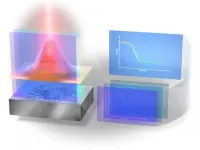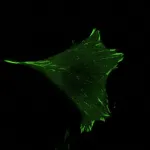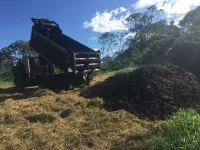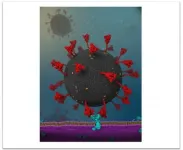Laser lights the way
A new way to observe laser interactions could improve laser-based manufacture
2021-03-29
(Press-News.org) Despite the enormous amount of research over the decades into lasers and their applications, there have been few ways to accurately, efficiently, and directly observe fine details of their interactions with materials. For the first time, researchers have found a way to acquire such data from a production laser using low-cost equipment that could vastly improve the accuracy of items cut or etched with lasers. Given the ubiquity of lasers, this could have wide-ranging implications in laboratory, commercial and industrial applications.
Lasers are used in an extraordinarily wide range of applications in the modern world. One area in particular that is increasingly important is in manufacture, the reason being the level of precision at which a laser can operate is far greater than that of the equivalent physical tool. However, this level of precision could be even higher in theory, leading to a new generation of yet unimagined technologies. There are some hurdles to overcome, though. One significant way in which laser precision could be improved is if there was a better means to obtain feedback on the way the laser interacts with a material. That way, there would be greater control and less uncertainty in the cutting and etching actions of a production laser. This problem has proven surprisingly difficult to tackle until now.
"To measure how far into a surface a laser has cut often requires tens or hundreds of depth readings to take place. This is a substantial barrier for fast, automated laser-based production systems," said Professor Junji Yumoto from the Department of Physics at the University of Tokyo. "So we have devised a new way to determine and predict the depth of a hole produced by laser pulses based on a single observation rather than tens or hundreds. This finding is an important step forward in improving the controllability of laser processing."
Yumoto and his team wondered how to determine the depth of a laser hole using the minimal amount of information possible. This led them to look at what is known as the fluence of a laser pulse, which is the optical energy the pulse delivers over a given area. Until recently, expensive imaging apparatus would have been required to observe this fluence, and this usually lacked sufficient resolution. But thanks to developments in other areas of electronics and optics, a relatively simple Raspberry Pi Camera Version 2 proved ample for the job.
As their test laser apparatus made a hole on sapphire, the camera recorded directly the fluence distribution of a laser pulse. Then a laser microscope measured the hole shape. By superimposing these two results and using some modern numerical methods, the team produced a large and reliable data set that could accurately tell you the relation between fluence and hole depth.
"This would be correspondent with the extraction of about 250,000 data points from a single measurement," said Yumoto. "Our new method could efficiently provide big data for machine learning and new numerical simulation methods to improve the accuracy and controllability of laser processing for manufacture."
INFORMATION:
Journal article
Haruyuki Sakurai, Kuniaki Konishi, Hiroharu Tamaru, Junji Yumoto, & Makoto Kuwata-Gonokami. Direct correlation of local fluence to single-pulse ultrashort laser to ablated morphology. Communications Materials.
https://doi.org/10.1038/s43246-021-00138-x
Funding and support
This work was supported in parts by MEXT Leading Graduates Schools Program, Advanced Leading Graduate Course for Photon Science (ALPS), MEXT Quantum Leap Flagship Program (MEXT Q-LEAP) Grant Number JPMXS0118067246, the Center of Innovation Program funded by the Japan Science and Technology Agency (JST), and the New Energy and Industrial Technology Development Organization (NEDO) project "Development of advanced laser processing with intelligence based on high-brightness and high-efficiency laser technologies (TACMI project)."
Useful links
Graduate School of Science
https://www.s.u-tokyo.ac.jp/en/index.html
Gonokami-Yumoto group
http://www.gono.t.u-tokyo.ac.jp/e_index.html
Related Q-LEAP project
https://www.jst.go.jp/stpp/q-leap/laser/en/index.html
Related NEDO project
https://www.nedo.go.jp/english/activities/activities_ZZJP_100124.html
Research contact
Professor Junji Yumoto
Department of Physics, The University of Tokyo,
7-3-1 Hongo, Bunkyo-ku, 113-0033 Tokyo, JAPAN
Tel: +81(0)3-5841-4082
Email: yumoto@ipst.s.u-tokyo.ac.jp
Press Contact
Mr. Rohan Mehra
Division for Strategic Public Relations, The University of Tokyo
7-3-1 Hongo, Bunkyo-ku, Tokyo 113-8654, JAPAN
Email: press-releases.adm@gs.mail.u-tokyo.ac.jp
About the University of Tokyo
The University of Tokyo is Japan's leading university and one of the world's top research universities. The vast research output of some 6,000 researchers is published in the world's top journals across the arts and sciences. Our vibrant student body of around 15,000 undergraduate and 15,000 graduate students includes over 4,000 international students. Find out more at http://www.u-tokyo.ac.jp/en/ or follow us on Twitter at @UTokyo_News_en.
[Attachments] See images for this press release:

ELSE PRESS RELEASES FROM THIS DATE:
2021-03-29
A team of Australian and German researchers has discovered a novel pathway that plants can use to save water and improve their drought tolerance.
The research published today in Nature Communications shows that the molecule GABA (gamma-aminobutyric acid), most commonly associated with relaxation in animals, can control the size of the pores on plant leaves to minimise water loss.
Matthew Gilliham, Director of the Waite Research Institute at the University of Adelaide, who led the research team, said they found: "GABA minimised pore openings in a range of crops such as barley, broad bean and soybean, and in lab plants that produce more GABA than normal. ...
2021-03-29
Each human being is made of billions of cells. In order to ensure his survival, cells must coordinate with each other and attach in the right place to perform their tasks. Scientists from the University of Geneva (UNIGE), Switzerland, in collaboration with the University of Tampere in Finland, have highlighted the key role of a protein called paxillin, which enables cells to perceive their environment and anchor at the right place with the help of cellular "crampons". Indeed, without functional paxillin, the cell is unable to attach properly and slips continuously. These results, to be read in the journal Communications Biology, shed new light ...
2021-03-29
Noninfluenza respiratory viral infections (NIRV) are associated with illness and death rates similar to influenza in hospitalized adults, according to new research in CMAJ (Canadian Medical Association Journal).
In a study of 2119 adults admitted to two hospitals over three seasons (2015-2018) in Edmonton, Alberta, and Toronto, Ontario, with confirmed viral acute respiratory infections, more than half (54.6%) were NIRV infections compared with influenza viruses (45.4%). Among patients with NIRV infections, 21.1% needed respiratory support, 18.2% required lengthy hospital stays and 8.4% died within 30 days of diagnosis. About 15% of NIRV infections were acquired in hospital.
"These findings show that clinical ...
2021-03-29
A new study finds that coffee pulp, a waste product of coffee production, can be used to speed up tropical forest recovery on post agricultural land. The findings are published in the British Ecological Society journal Ecological Solutions and Evidence.
In the study, researchers from ETH-Zurich and the University of Hawai`i spread 30 dump truck loads of coffee pulp on a 35 × 40m area of degraded land in Costa Rica and marked out a similar sized area without coffee pulp as a control.
"The results were dramatic" said Dr Rebecca Cole, lead author ...
2021-03-29
Twenty percent of high school students have easy access to a handgun, according to a new study from the Colorado School of Public Health on the University of Colorado Anschutz Medical Campus.
In the study published today in The Journal of Pediatrics, the researchers examined the prevalence of handgun access among adolescents in Colorado and explored individual and geographic characteristics, as well as related health factors.
"Our findings highlight that it is relatively easy to access a handgun in Colorado for high school students. This finding, combined with ...
2021-03-29
Growing cities tend to run out of land for waste management and new landfill sites.
Artificial Intelligence can help city managers create more powerful long-term forecasts of solid waste volumes and landfill requirements, even with missing or inaccurate data.
UJ researchers found that a 10-neuron model produced the best 30-year forecast for municipal solid waste in a growing city.
All over the world, large cities are running out of space for municipal solid waste. Existing landfill sites are rapidly filling up and no-one wants a new site anywhere near their homes or businesses. Meanwhile, taxpayers aren't interested in higher costs for quality waste management either.
One way of significantly extending ...
2021-03-29
Groundbreaking research from the University of South Australia has delivered world-first national-level guidelines to better inform children's physical activity and screen time in Outside School Hours Care (OSHC).
Developed with input from the OSHC sector, the guidelines aim to address growing concerns of children's sedentary behaviour marked by an increase in regular screen time. Research shows that 31-79 per cent of OSHC sessions are sedentary.
The guidelines specifically encourage energetic play while discouraging screen use:
Before School Care should schedule 45 minutes of physical activities and no more ...
2021-03-29
Arctic habitats have fascinated biologists for centuries. Their species-poor insect faunas, however, provide little reward for entomologists - scientists who study insects - to justify spending several weeks or even months in the hostile environments of tundra or polar deserts. As a result, data on insects from the High Arctic islands are often based on occasional collecting and remain scarce.
Vize Island, located in the northern part of the Kara Sea, is one of the least studied islands of the Russian High Arctic in terms of its biota. Scientists Dr Maria V. Gavrilo of the Arctic ...
2021-03-29
WATERLOO, Ontario, March 29, 2021--A newly-published paper represents one of the most comprehensive reviews of advancements to come in contact lenses, catapulting the commonly-used medical device to applications well beyond refractive error correction.
Contact Lens Technologies of the Future (Jones L, et al.) is now in press from Contact Lens and Anterior Eye, the peer review journal of the British Contact Lens Association (BCLA). It joins nine other papers being printed in next month's special edition as part of the BCLA-led Contact Lens Evidence-based Academic Reports (CLEAR) series.
"There are a range of ...
2021-03-29
Bioengineering researchers at Lehigh University have identified a previously unknown interaction between receptors in human cells and the spike, or "S," protein of SARS-CoV-2, the virus that causes COVID-19. This new information could aid in the development of new strategies to block SARS-CoV-2 entry into human cells.
X. Frank Zhang and Wonpil Im knew from recent studies that the interaction between the SARS-CoV-2 spike protein and angiotensin-converting enzyme 2 (ACE2) receptors in human cells is stronger than the interaction between the structurally identical spike protein of SARS-CoV-1, the virus that caused the 2002-2004 SARS outbreak, and the same receptors.
"Our goal was to characterize SARS-CoV-2 ...
LAST 30 PRESS RELEASES:
[Press-News.org] Laser lights the way
A new way to observe laser interactions could improve laser-based manufacture






